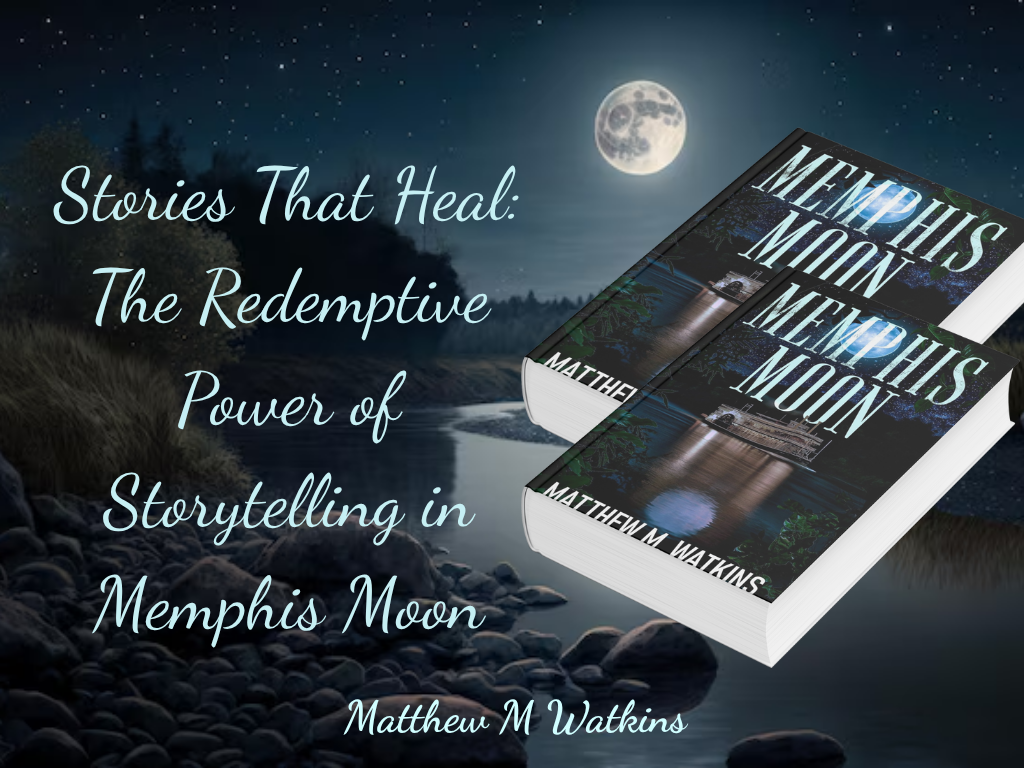In Memphis Moon, Matthew M. Watkins turns storytelling itself into an act of salvation. Beyond its rich characters and historical texture, the novel is ultimately about the power of words, how writing, reading, and remembering can mend what grief and time have broken. Every thread in the story, from Ginnie Moon’s hidden diary to Caleb Dawkins’s journey of rebuilding, speaks to the same truth: that telling our stories is how we survive.
The diary at the center of Memphis Moon is more than a relic. It’s a vessel of healing. When Ginnie Moon writes during the war, her words are not just observations; they are confessions, prayers, and acts of resistance. Ginnie writes because she has to. The world around her is breaking down, falling apart, and her writing becomes a way to preserve her sanity and herself through this immense loss. Through Ginnie’s voice, Watkins captures the deep connection between storytelling and endurance. Each entry in the diary is a piece of herself that she is keeping preserved, locked so that she can recover. This is a memoir of her and a record, so that she may always remember and live on through the words she has written.
When that same diary is discovered in modern times, its healing power extends beyond its author. The young woman who finds it, separated by generations from Ginnie, experiences something more profound than curiosity. As she reads, she begins to absorb the strength of the woman whose life she uncovers. Watkins uses this discovery to illustrate how stories can restore what time tries to erase, not by undoing pain, but by transforming it into meaning.
Caleb Dawkins’s story echoes this same redemptive pattern. Though he doesn’t write, his actions tell their own story. In the part where the gristmill is being rebuilt, the theme of the tone itself becomes an unspoken, silent narration of forgiveness. Every motion of cutting, hammering, and restoring becomes a slight “I’m sorry”. It becomes a narrative of survival, of enduring, and of recovery. Watkins presents this physical storytelling alongside Ginnie’s written one, as if to say that all forms of creation, whether through words, work, or compassion, are ways of narrating our way back to wholeness.
Watkins’s tone reinforces this belief. He writes with a reverence for the human need to be remembered, to be heard. One of the most striking features of Matthew M. Watkins’s storytelling is that it is gentle. He does not treat writing as a quick escape from suffering or slow it down to make every word feel like an event. His gentleness is prevalent in his prose as he takes the road in the middle; his writing helps experience the characters’ suffering in a realistic, empathetic manner; however, it also provides a clear way of moving through it with the plot. His characters are not healed by forgetting, but by facing what hurts and giving it language. Ginnie’s words hold her heartbreak and her courage in equal measure; Caleb’s labor holds his grief and his faith in the same hands. This balance, this honesty, is what makes their stories redemptive rather than tragic.
Even Lottie Moon’s faith-driven life reflects the healing rhythm of storytelling. Her missionary work and letters of devotion become her own form of narrative, one that continues long after she is gone. Watkins’s inclusion of her legacy reminds readers that healing doesn’t always happen within a single lifetime. Sometimes it’s carried forward by those who come after, who find pieces of themselves in the stories left behind.
By the writing of Memphis Moon being structured into two different timelines, Watkins demonstrates that storytelling and writing are the thread that unites us all throughout the ages. The past speaks the loudest, the present is listening and seeing, and the future thinks. Through this exchange of senses, the timeline is balanced and fair. The diary is not a recounting of simple events, but a memoir of feelings and emotions, being transferred from one person to another. The modern reader’s act of uncovering it is an act of faith in the redemptive power of story itself.
Watkins’s prose, gentle yet resonant, reflects the novel’s message: that stories do not end; they echo. The words Ginnie wrote in solitude ripple through time, touching a stranger’s life and, by extension, ours. Through them, Watkins makes a quiet but enduring promise that no sorrow is ever wasted if it’s turned into a story, and no story truly dies as long as someone remembers to tell it.
Memphis Moon leaves readers with a profound sense of gratitude, not just for the lives it portrays, but for the act of storytelling itself. It reminds us that words can carry light into dark places, that the simple act of writing or reading can heal what history and heartbreak cannot. In Watkins’s hands, storytelling becomes not only art, but grace, the way we remember, the way we forgive, and the way we begin again.

